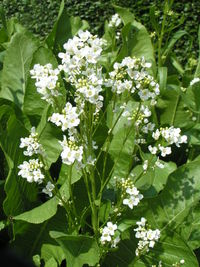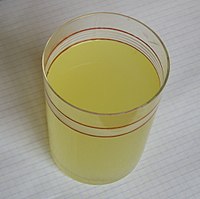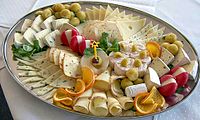
Some microbiological, physicochemical and ripening properties of Erzincan Tulum cheese produced with added black cumin (Nigella sativa L.)
Sign Up to like & getrecommendations! Published in 2018 at "Journal of Food Science and Technology"
DOI: 10.1007/s13197-018-3058-5
Abstract: The effects of black cumin (BC) at 0, 1 or 2% in Erzincan Tulum cheese (Tulum cheese) on its microbiological, chemical and proteolysis properties during ripening were investigated. The addition of BC caused an increase… read more here.
Keywords: cheese produced; erzincan tulum; tulum cheese; dry matter ... See more keywords

The fungal problem in cheese industry
Sign Up to like & getrecommendations! Published in 2019 at "Current Opinion in Food Science"
DOI: 10.1016/j.cofs.2019.07.003
Abstract: Mould growth on cheese represents both a quality and a food safety problem, and poses significant economic losses. Several mould genera may destroy cheese; however, normally just a few fungal species dominate on a specific… read more here.
Keywords: problem cheese; cheese; fungal problem; cheese industry ... See more keywords

Modifying textural and microstructural properties of low fat Cheddar cheese using sodium alginate
Sign Up to like & getrecommendations! Published in 2018 at "Food Hydrocolloids"
DOI: 10.1016/j.foodhyd.2018.03.015
Abstract: Low fat Cheddar cheese (LFC) with up to 91% fat reduction were prepared using four levels of sodium alginate (alginate): 0.12 (LFCA1), 0.17 (LFCA2), 0.18 (LFCA3) and 0.23% (w/w) (LFCA4). Control full fat cheese (CFFC)… read more here.
Keywords: alginate; low fat; fat cheddar; cffc ... See more keywords

Conventional and omics approaches shed light on Halitzia cheese, a long-forgotten white-brined cheese from Cyprus
Sign Up to like & getrecommendations! Published in 2019 at "International Dairy Journal"
DOI: 10.1016/j.idairyj.2019.06.010
Abstract: Abstract Production and ripening of Halitzia cheese was examined by conventional physicochemical and microbiological analyses along with state-of-the art metagenomics. Cheese was made from (A) raw goat milk without the addition of starters; (B) pasteurised… read more here.
Keywords: conventional omics; approaches shed; halitzia cheese; omics approaches ... See more keywords

Study of the effectiveness of staphylococcins in biopreservation of Minas fresh (Frescal) cheese with a reduced sodium content.
Sign Up to like & getrecommendations! Published in 2019 at "International Journal of Food Microbiology"
DOI: 10.1016/j.ijfoodmicro.2019.05.014
Abstract: Abstract Reducing salt content in foods such as cheeses, while limiting the growth of spoilage microorganisms and foodborne pathogens, is a difficult challenge. One method that may prove useful is use of staphylococcins, which are… read more here.
Keywords: sodium content; cheese; minas fresh; content ... See more keywords

Control of Listeria monocytogenes growth and virulence in a traditional soft cheese model system based on lactic acid bacteria and a whey protein hydrolysate with antimicrobial activity.
Sign Up to like & getrecommendations! Published in 2021 at "International journal of food microbiology"
DOI: 10.1016/j.ijfoodmicro.2021.109444
Abstract: "Torta del Casar" is a Spanish soft-ripened cheese made with sheep's raw milk and subjected to a short ripening process, which favors the growth of pathogenic microorganisms including Listeria monocytogenes. The development of strategies to… read more here.
Keywords: cheese; whey protein; acid bacteria; growth ... See more keywords

Modelling CO 2 transfer in foil ripened semi-hard Swiss-type cheese
Sign Up to like & getrecommendations! Published in 2018 at "Journal of Food Engineering"
DOI: 10.1016/j.jfoodeng.2017.10.025
Abstract: Abstract Despite CO2 production and diffusion during ripening of semi-hard Swiss-type cheese are considered as important quality parameters, the research concerning key gas production and transfer in cheese remains widely overlooked. In this study, experimentally… read more here.
Keywords: hard swiss; type cheese; swiss type; semi hard ... See more keywords

Milk microbiota: Characterization methods and role in cheese production.
Sign Up to like & getrecommendations! Published in 2019 at "Journal of proteomics"
DOI: 10.1016/j.jprot.2019.103534
Abstract: Milk is a complex body fluid aimed at addressing the nutritional and defensive needs of the mammal's newborns. Harbored microbiota plays a pivotal role throughout the cheesemaking process and contributes to the development of flavor… read more here.
Keywords: milk; dairy microbiota; role; dairy ... See more keywords

Use of caprifig tree extract as a substitute for calf rennet in goat’s fresh cheese production
Sign Up to like & getrecommendations! Published in 2021 at "Small Ruminant Research"
DOI: 10.1016/j.smallrumres.2021.106382
Abstract: Abstract The objective of this study was to evaluate the clotting ability of a natural product extracted from leaves and stems of the wild fig (Ficus carica L.) using a simple and chemical-free method as… read more here.
Keywords: calf rennet; extract; caprifig tree; cheese ... See more keywords

Microalgae: A new source of healthy ingredients. Antioxidant and antimicrobial properties and incorporation as a functional ingredient for cheese making
Sign Up to like & getrecommendations! Published in 2020 at "Proceedings of the Nutrition Society"
DOI: 10.1017/s0029665120005273
Abstract: Abstract Antimicrobial and antioxidant activities of nine species of microalgae have been determined to study its potential as healthy ingredients for functional foods. In order to determine the antioxidant capacity, two different techniques have been… read more here.
Keywords: presence; healthy ingredients; cheese; new source ... See more keywords

Changes in the physicochemical, microstructural and rheological properties of traditional Kope cheese during ripening
Sign Up to like & getrecommendations! Published in 2018 at "International Journal of Dairy Technology"
DOI: 10.1111/1471-0307.12434
Abstract: The effect of ripening time on the microstructural, physicochemical and rheological characteristics of traditional Kope cheese ripened in clay pots was investigated. The moisture content, pH and total nitrogen (TN)/dry matter (DM) of the cheese… read more here.
Keywords: traditional kope; physicochemical microstructural; changes physicochemical; kope cheese ... See more keywords